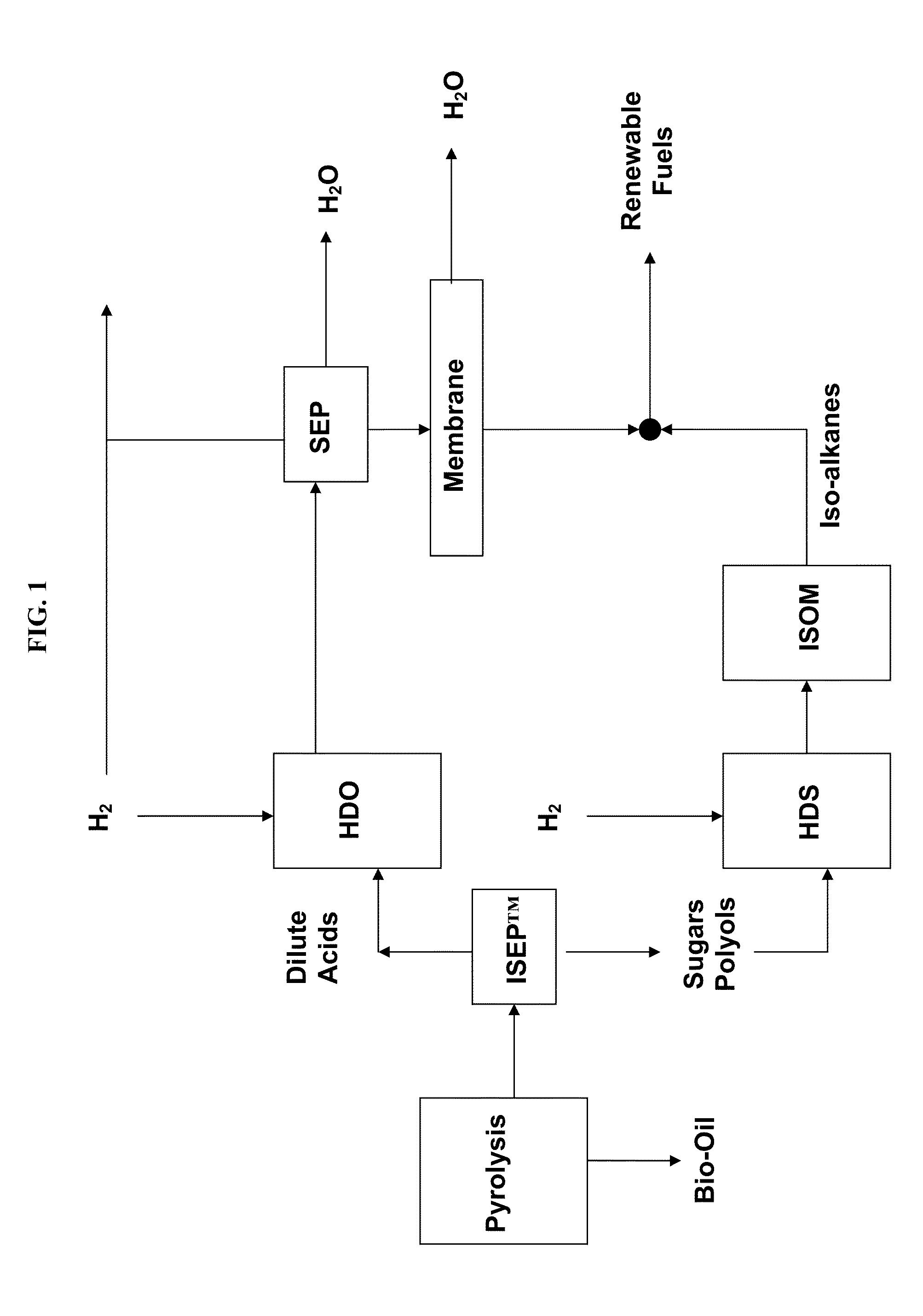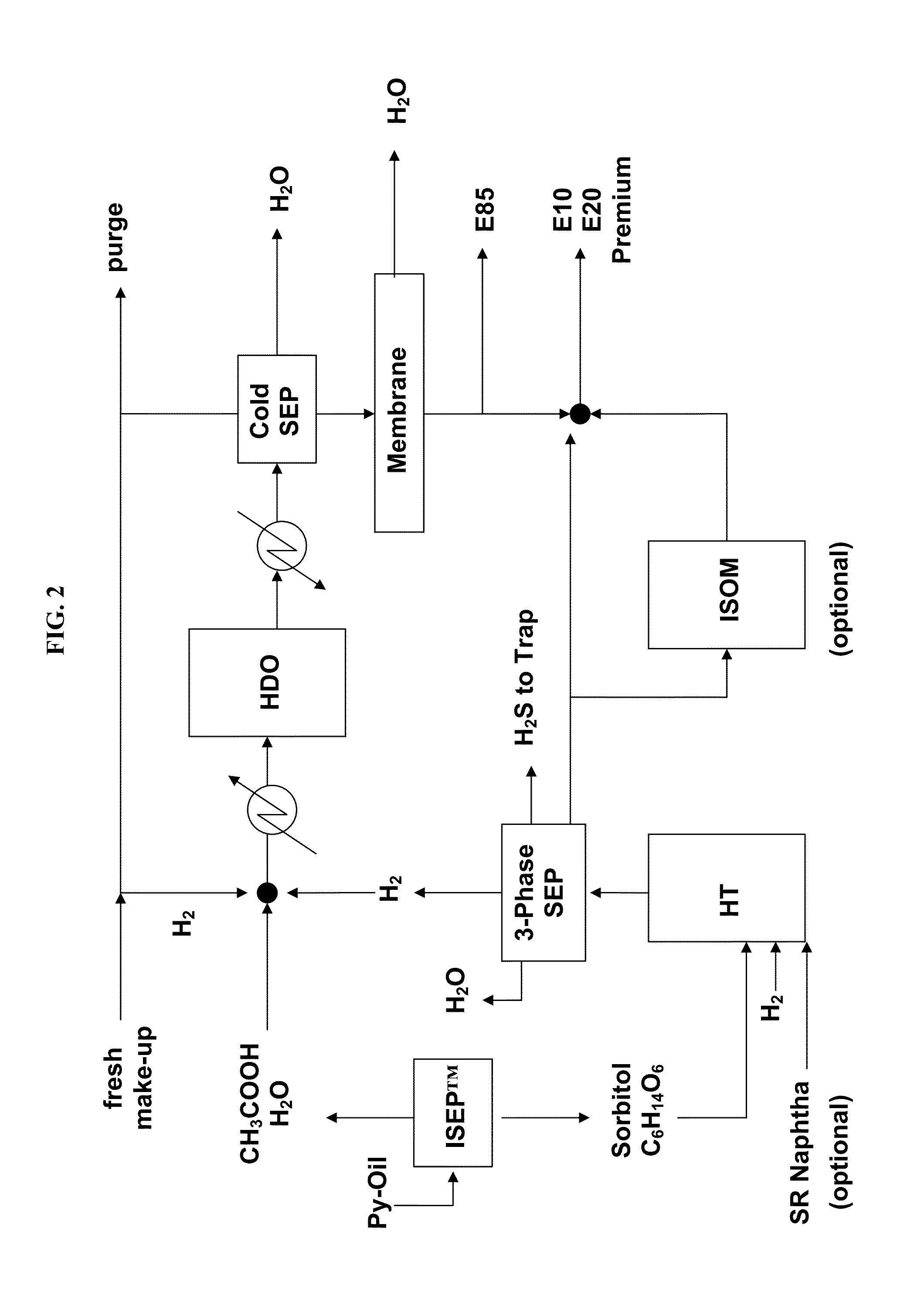Advanced cellulosic renewable fuels
a technology of renewable fuels and advanced cellulosic, which is applied in the direction of fuels, sustainable manufacturing/processing, petrochemical industry, etc., can solve the problems of unstable storage and phase separation, poor combustion characteristics, and instability, and achieve the effect of improving the combustion efficiency and reducing the cost of raw materials
- Summary
- Abstract
- Description
- Claims
- Application Information
AI Technical Summary
Benefits of technology
Problems solved by technology
Method used
Image
Examples
example 1
HDO
[0052]Light organic acids compose a major portion of the pyrolysis oil (up to 10 wt %) product used for producing biofuels. These organic acids generally appear in low concentrations within the aqueous fractions of the pyrolysis oil. Reconstitution of pyrolysis oil from essentially these aqueous waste streams into biofuels is accomplished by HDO. HDO produces alcohols from this organic acids which may be directly blended into conventional fuels. Several catalysts were identified and examined for their relative activity in converting a model stream of acetic acid to ethanol. One catalyst (CuO / ZnO / Al2O3) was selected to carry-out HDO, and a matrix of designed experiments were performed to model the conversion over a range of conditions. CuO / ZnO / Al2O3 produced a variety of products at high conversion (94% conversion), and a high yield, 75%, of ethanol.
[0053]CuO / ZnO / Al2O3 synthesis gas conversion catalyst with a MgO promoter was prepared via coprecipitation (nominally 67.3% CuO, 22.8...
example 2
Pervaporation Membrane Unit
[0062]Pervaporation is a membrane-based technique used for separation of liquid mixtures and in particular for challenging separation of azeotropes and close-boiling components. For example, binary mixtures of water and ethanol form an azeotrope at 95% ethanol. With the anticipated need for reducing the carbon footprint in an operation, pervaporation can provide an alternative to certain distillation steps thus making refinery operations more energy efficient. A pervaporation membrane testing unit (FIG. 8B) and its validation using commercial membranes is described. It illustrates the basics of pervaporation, the experimental procedure and analysis required to assess membrane performance. In one embodiment, 80% of the water is removed from a 90 / 10 wt % ethanol / water mixture using a hydrophilic (SULZER PERVAP2200®) membrane. In addition to 90 / 10 ethanol / water separation, commercial grade pervaporation systems can be used to separate hydrocarbon mixtures on ...
example 3
Production of Advanced Cellulosic Renewable Fuels
[0073]A complete system and method of producing advanced cellulosic renewable fuels has been developed that uses an biomass source with high levels of oxygenate and converts the oxygenated biomass to ethanol and blended ethanol renewable gasoline fuels. Oxygenates, including soluble carbohydrates, organic acids, polyols, and alcohols are produced from biomass through a variety of reactions including acid hydrolysis, pyrolysis, fermentation and other conventional biomass conversions. The oxygen rich aqueous solutions are difficult to process because of the corrosive nature of oxygenate containing solutions and subsequent coking propensity of these mixtures inside reactors. The system developed (FIG. 1) produces gasoline range fuels and fuel grade alcohols ready to blend as advanced cellulosic renewable fuels that are fungible with current gasoline products. This method demonstrates the production of a neat fuel product blend that can b...
PUM
 Login to View More
Login to View More Abstract
Description
Claims
Application Information
 Login to View More
Login to View More - R&D
- Intellectual Property
- Life Sciences
- Materials
- Tech Scout
- Unparalleled Data Quality
- Higher Quality Content
- 60% Fewer Hallucinations
Browse by: Latest US Patents, China's latest patents, Technical Efficacy Thesaurus, Application Domain, Technology Topic, Popular Technical Reports.
© 2025 PatSnap. All rights reserved.Legal|Privacy policy|Modern Slavery Act Transparency Statement|Sitemap|About US| Contact US: help@patsnap.com



